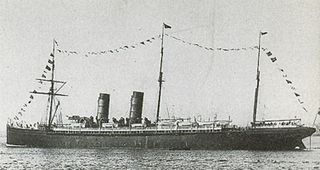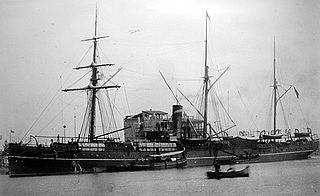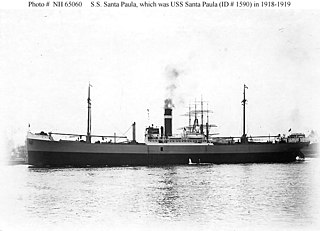
SS Chelyuskin was a Soviet steamship, reinforced to navigate through polar ice, that in 1934 became ice-bound in Arctic waters during a navigation along the Northern Maritime Route from Murmansk to Vladivostok and sank. 111 people were on board the Chelyuskin, and all but one were rescued by air. The expedition's task was to determine the possibility to travel by non-icebreaker through the Northern Maritime Route in a single navigation season.

Essex was an American whaling ship from Nantucket, Massachusetts, which was launched in 1799. On November 20, 1820, while at sea in the southern Pacific Ocean under the command of Captain George Pollard Jr., the ship was attacked and sunk by a sperm whale. About 2,000 nautical miles (3,700 km) from the coast of South America, the 20-man crew was forced to make for land in three whaleboats with what food and water they could salvage from the wreck.

USS Santiago de Cuba was a side-wheel steamship acquired by the Union Navy during the first year of the American Civil War. She was outfitted as a gunboat with powerful 20-pounder rifled guns and 32-pounder cannon and was assigned to the Union blockade of the Confederate States of America. She was notably successful in this role, capturing several blockade runners. Her last major action of the war was the assault on Fort Fisher, during which seven of her crew won the Medal of Honor.

General Grant was a 1,005-ton three-masted bark built in Maine in the United States in 1864 and registered in Boston, Massachusetts. It was named after Ulysses S. Grant and owned by Messers Boyes, Richardson & Co. She had a timber hull with a length of 179.5 ft, beam of 34.5 ft and depth of 21.5 ft. While on her way from Melbourne to London, General Grant crashed into a cliff on the west coast of main island of the Auckland Islands of New Zealand, and subsequently sank as a result. Sixty-eight people drowned and only 15 people survived.
A custom of the sea is a custom said to be practiced by the officers and crew of ships and boats in the open sea, as distinguished from maritime law, which is a distinct and coherent body of law governing maritime questions and offenses.

Valbanera was a steamship operated by the Pinillos Line of Spain from 1905 until 1919, when she sank in a hurricane with the loss of all 488 crew and passengers aboard. Valbanera was a 400-foot-long (120 m) steamer capable of carrying close to 1,200 passengers. She sailed a regular route between Spain and Puerto Rico, Cuba, and the Gulf Coast of the United States. The ship sank with the loss of all 488 people on board during the Florida Keys Hurricane in September 1919.

The SS City of Rio de Janeiro was an iron-hulled steam-powered passenger ship, launched in 1878, which sailed between San Francisco and various Asian Pacific ports. On 22 February 1901, the vessel sank after striking a submerged reef at the entry to San Francisco Bay while inward bound from Hong Kong. Of the approximately 220 passengers and crew on board, fewer than 85 people survived the sinking, while 135 others were killed in the catastrophe. The wreck lies in 287 feet (87 m) of water just off the Golden Gate and is listed in the National Register of Historic Places as nationally significant.

RMS Umbria and her sister ship RMS Etruria were the last two Cunard Line ocean liners that were fitted with auxiliary sails. Umbria as the last express steamship to be built for a North Atlantic route with a compound engine. By 1885, the triple expansion engine was the almost universal specification for newly built steamships. John Elder & Co. built Umbria in Govan, Glasgow, in 1884.

SS Pacific was a wooden sidewheel steamer built in 1850 most notable for its sinking in 1875 as a result of a collision southwest of Cape Flattery, Washington. Pacific had an estimated 275 passengers and crew aboard when she sank. Only two survived. Among the casualties were several notable figures, including the vessel's captain at the time of the disaster, Jefferson Davis Howell (1846–1875), the brother-in-law of former Confederate President Jefferson Davis. The sinking of Pacific killed more people than any other marine disaster on the West Coast at the time.

Sechelt was an American steamship which operated from 1893 to 1911 on Lake Washington, Puget Sound and the Strait of Georgia, mostly as a passenger ferry with routes between Washington state and British Columbia. For most of her career, she was called Hattie Hansen. She became well known following her unexplained sinking with no survivors near Race Rocks Lighthouse in 1911.

Loch Vennachar was an iron-hulled, three-masted clipper ship that was built in Scotland in 1875 and lost with all hands off the coast of South Australia in 1905. She spent her entire career with the Glasgow Shipping Company, trading between Britain and Australia. The company was familiarly called the "Loch Line", as all of its ships were named after Scottish lochs. The ship was named after Loch Venachar, in what was then Perthshire.
SS Hong Moh was a passenger ship that was wrecked on the White Rocks off Lamock Island, Swatow, on 3 March 1921 with the loss of about 900 lives.

The SS Mohegan was a steamer which sank off the coast of the Lizard Peninsula, Cornwall, on her second voyage. She hit The Manacles on 14 October 1898 with the loss of 106 out of 197 on board.
SS Cambria was a British cargo-passenger steamship wrecked off the north-west of Ireland on 19 October 1870 with the loss of 178 lives.

SS Washingtonian was a cargo ship launched in 1913 by the Maryland Steel Company of Sparrows Point, Maryland, near Baltimore, as one of eight sister ships for the American-Hawaiian Steamship Company. At the time of her launch, she was the largest cargo ship under American registry. During the United States occupation of Veracruz in April 1914, Washingtonian was chartered by the United States Department of the Navy for service as a non-commissioned refrigerated supply ship for the U.S. fleet stationed off the Mexican coast.

The SS Bokhara was a P&O steamship which sank in a typhoon on 10 October 1892, off the coast of Sand Island in the Pescadores, Formosa. Of the 150 people who perished, eleven were members of the Hong Kong cricket team.

SS Santa Paula was a freighter of the Grace Line and later the American-Hawaiian Steamship Company. The vessel also saw military transport service during both World Wars.
MV C.O. Stillman was an oil tanker that was built by a German shipyard in 1928 for a Canadian-based shipping company. A Panamanian subsidiary of Esso bought her at the end of 1936 and she was sunk by the German submarine U-68 in the Caribbean on June 4, 1942 about 41 nautical miles (76 km) southwest of Isla de Mona, Puerto Rico.
The SS Trebartha was a 4,597 GRT cargo carrying steamship built in 1920 by John Readhead & Sons Ltd of South Shields for the Hain Steamship Company. She was attacked by German aircraft on the 11th November and sank on the 12th November 1940.

The S.S. Golden Gate was a mail and passenger steamer that operated between San Francisco and Panama City from 1851 to 1862. On its last voyage from San Francisco it caught fire and was destroyed with the loss of 204 lives off Manzanillo, Colima, Mexico. The ship was carrying $1,400,000 in gold coins for Wells Fargo, as well as large amounts of gold and coins for the passengers. Much of this was retrieved, but amateurs continue to search for gold with metal detectors on what is now called the Playa de Oro.














